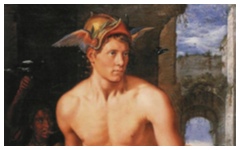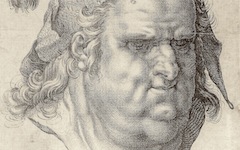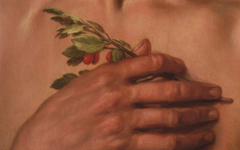Goltzius’ Sleeping Danae… (1603)

Goltzius, The Sleeping Danae Being Prepared to Receive Jupiter (1603) Oil on canvas. Los Angeles County Museum of Art.
Click image to enlarge.
Goltzius' masterpiece, The Sleeping Danae Being Prepared to Receive Jupiter, is an often overlooked example in a long tradition of reclining nudes, from Venetian Venuses to Spanish Majas and the various courtesans in modern art. As in other examples explained here, the nude is the "painting" within the painting. Those around her then, and the eagle as Jupiter, are representations of the "divine" craftsman, Goltzius. The artist's name derives from "gold" so the fact that Zeus uses gold to impregnate the nude is an intentional self-reference. He probably chose the subject himself.
Click next thumbnail to continue

Top: Goltzius, The Sleeping Danae......
Bottom: Manet, Olympia (1863) Oil on canvas. Musée d'Orsay, Paris.
Click image to enlarge.
The African maid in Manet's Olympia (bottom) has already been described as the "artist" holding his palette (of flowers) behind his finished "painting", the nude Olympia. (She even has, as I show in the second part of that entry, the features of Rembrandt's face!)1 Clearly the Danae (top) is a similar painting despite the quite different narrative. The evidence in support of this interpretation includes....
Click next thumbnail to continue

Top: Goltzius, The Sleeping Danae......, detail
Bottom: Goltzius, Hand Study, inverted and rotated (1588) Pen and ink on paper.
Click image to enlarge.
....Goltzius' right hand as the servant's left one suggesting furthermore that he is looking into the mirror of his mind. His had been deformed since childhood (bottom) but, if you imagine the abbreviated finger lengthened, the hand touching the Danae's shoulder has fingers in a nearly identical formation. Besides, touching, as explained under that theme, is a little-known metaphor in art for "painting".2
Click next thumbnail to continue

Left: Goltzius, The Sleeping Danae......, detail
Right: Goltzius, Mercury (1611-13) Oil on canvas.
Click image to enlarge.
Goltzius clearly identified with the messenger of the gods, Mercury, as can be seen in a large portrait of the divinity as an artist (right). Mercury was even considered the "inventor" of the arts.3 He appears again in the Danae looking onto the scene while pointing with his caduceus towards Jupier (left). He thus appears to paint the divine world in the background while the servant paints the human world in the foreground. As in many portraits of artists together, they are a group- or double-act.4
Most scenes show the Danae being impregnated by Jupiter. Here, though, she dreams (like an artist) while being prepared for it just as Goltzius was in a similar process while painting the canvas, preparing the finished picture. Separately, Jupiter's' money-bags being held by a spiritello on the left are often noted as a phallic symbol for the coming act but, in conjunction with the fertile Danae's female nudity, which is also a representation of the artist's conceptual powers, Goltzius presents his mind as androgynous. Or perhaps, to put it more appropriately, he rises above gender to paint a masterpiece for all humanity.
More Works by Goltzius
With Mercury outfitted as a painter, the viewer can interpret this image confident that the subject is art

Goltzius’ Mercury (1611-13)
Notes:
1. See enties on Manet's Olympia Part 1, Manet's Olympia Part 2, Titian's Venus with an Organist (c.1550), Lucas Cranach the Elder's Cupid and Venus Woodcut (1506) and Van Dyck's Titian with His Mistress (1630's). See also the joint entry, Titian’s Venus (c.1548-9) and Manet’s Olympia (1863).
2. See the theme Pointing and Touch.
3. Lawrence Nichols, “The Pen Works of Hendrick Goltzius”, Philadelphia Museum of Art Bulletin 88, Winter 1992, p. 11
4. Examples, to name a few, include Raphael's so-called Self-portrait with a Friend (probably another artist), Signorelli's self-portrait with Fra Angelico in the Cathedral at Orvieto, Veronese's Marriage at Cana with Titian and others, Ingres' Apotheosis of Homer and Manet's self-portrait with the artist Albert de Balleroy in Concert in the Tuileries.
Original Publication Date on EPPH: 17 Jun 2013. | Updated: 0. © Simon Abrahams. Articles on this site are the copyright of Simon Abrahams. To use copyrighted material in print or other media for purposes beyond 'fair use', you must obtain permission from the copyright owner. Websites may link to this page without permission (please do) but may not reproduce the material on their own site without crediting Simon Abrahams and EPPH.



